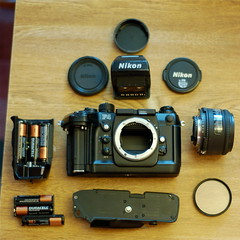Penmachine
02 August 2008
Learn how your camera works: an introduction
 Late next month, on Saturday, September 27, we'll be holding another BarCamp attendee-organized tech conference here in Vancouver. It's already sold out. Part of the event will be PhotoCamp, dedicated to all things photographic—the most recent one of these in Vancouver was at Northern Voice in February.
Late next month, on Saturday, September 27, we'll be holding another BarCamp attendee-organized tech conference here in Vancouver. It's already sold out. Part of the event will be PhotoCamp, dedicated to all things photographic—the most recent one of these in Vancouver was at Northern Voice in February.
My wife Air and I are both going. I'm not yet sure if I'll be in good enough shape to participate all that actively, since I will have chemotherapy earlier that week, but I'll almost certainly be much, much better than I was last year, when I was just out of hospital, about 50 pounds lighter than I am now, and she had to push me there in a wheelchair.
Anyway, BarCamp and my recent rekindling of an interest in photography more generally have prompted me to start a bit of a series here on the blog. If I'm up for it I may provide a summary at the PhotoCamp part of the meeting.
Focal length, f-stops, and crop factors demystified
I want to explain some basic photographic terms: those words and numbers I've been using since I started taking pictures seriously in the '80s—but some of which I've only vaguely understood. I'll do so in a series of blog posts aimed at digital photographers, but I'll use my film-based Nikon F4 camera to show what's going on, because it's conducive to being partially disassembled, to show the workings of its parts.
I won't be tackling this stuff in excruciating technical detail: I'm not an engineer or lens designer, and the last time I studied optics was at least a couple of decades age. But I want to demystify some of the funky terminology photo enthusiasts throw around all the time—for myself as much as anyone. Even experienced photographers I know, who have developed an intuitive sense for exposure settings, composition, and lens choices, don't always know the answers to such basic questions as:
- When we talk about a lens's focal length, what do we really mean?
- What do aperture f-numbers like f/1.4 or f/16 represent?
- Why do those f-numbers and shutter speeds have the values they do, and how are they related?
- Why do most digital cameras have a crop factor (like 1.5, 1.6, or 2.0) for their lenses, while film cameras don't?
- Where do ISO and EV numbers come from, and what do they indicate?
- Why is the flash sync shutter speed of most cameras much slower than the fastest shutter speed you can use without a flash?
Short tips to help make better pictures
Knowing this stuff is not pure geekery. If you like photography, understanding why these terms exist and have the values they do will help you take better pictures.
I plan to keep the blog posts as short as I can, sticking to the core of each topic. Inevitably I'll probably also get some of my explanations wrong, so I hope those of you who understand the subject better will correct me in the comments. I'll start with focal length in the next day or two—and I hope I have it figured out in my own mind by then!
Labels: barcamp, cameraworks, geekery, photography
Comments:
I'm enjoying your explanations, and how you're tying the separate parts together.
Something is slowly assembling itself in my brain.


